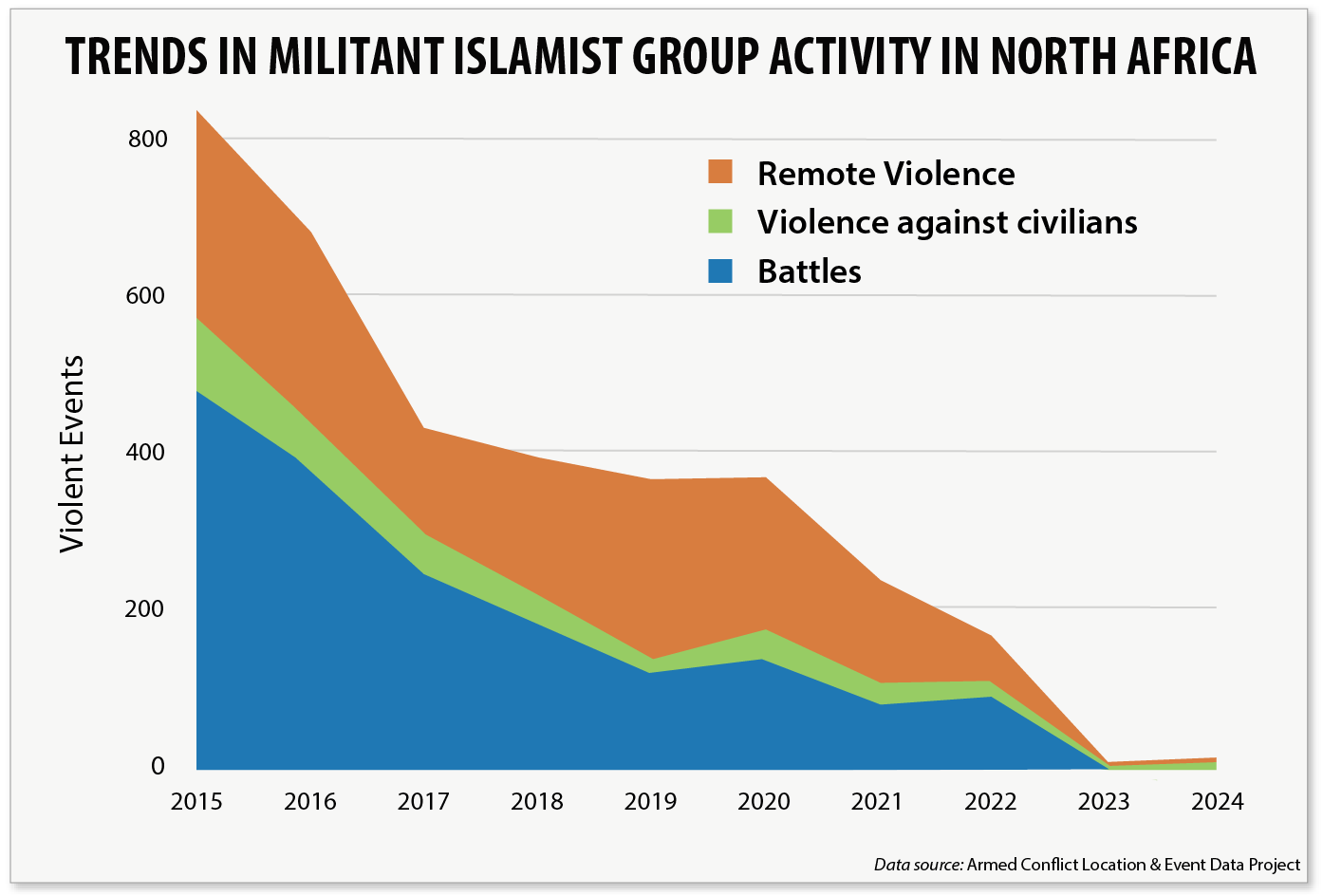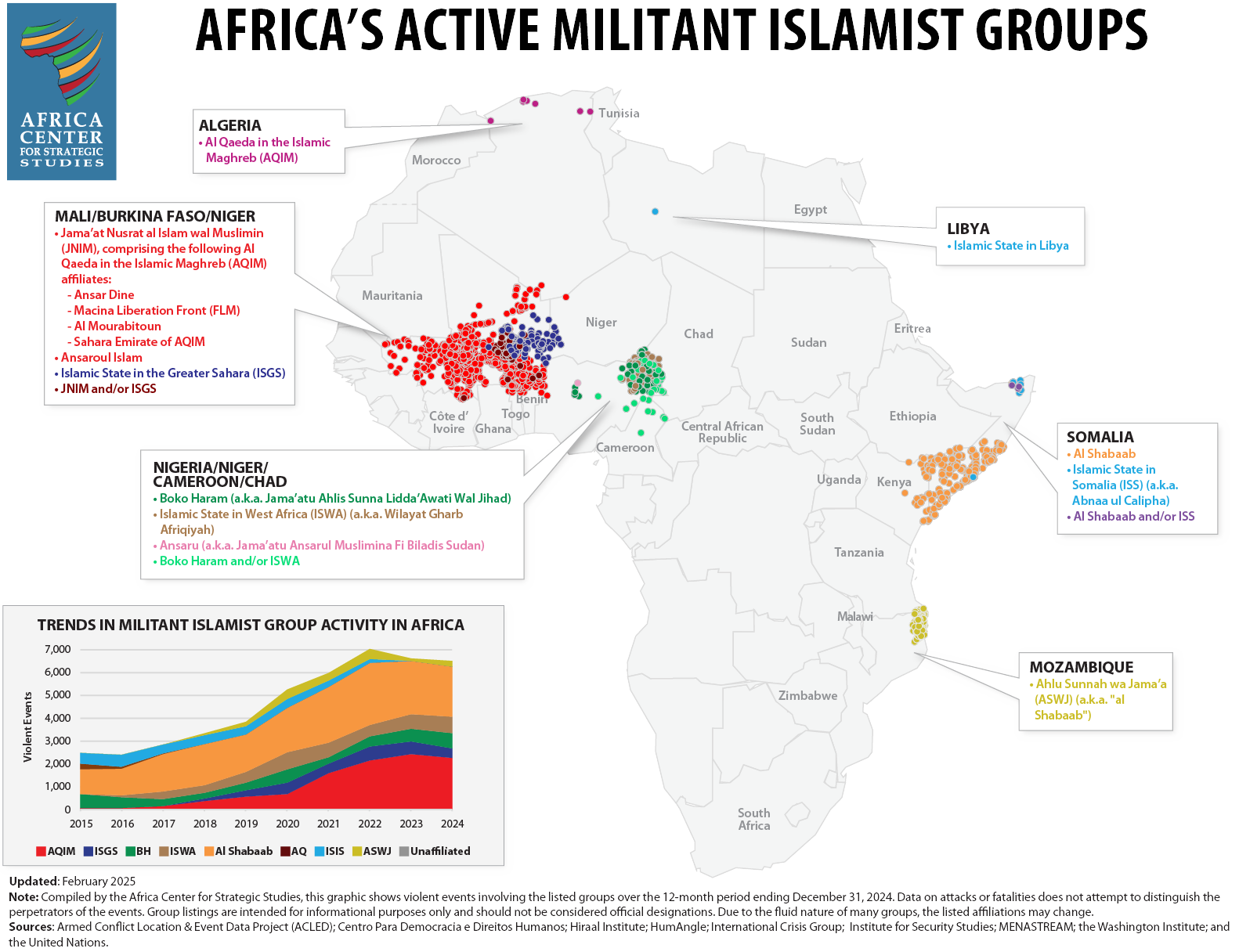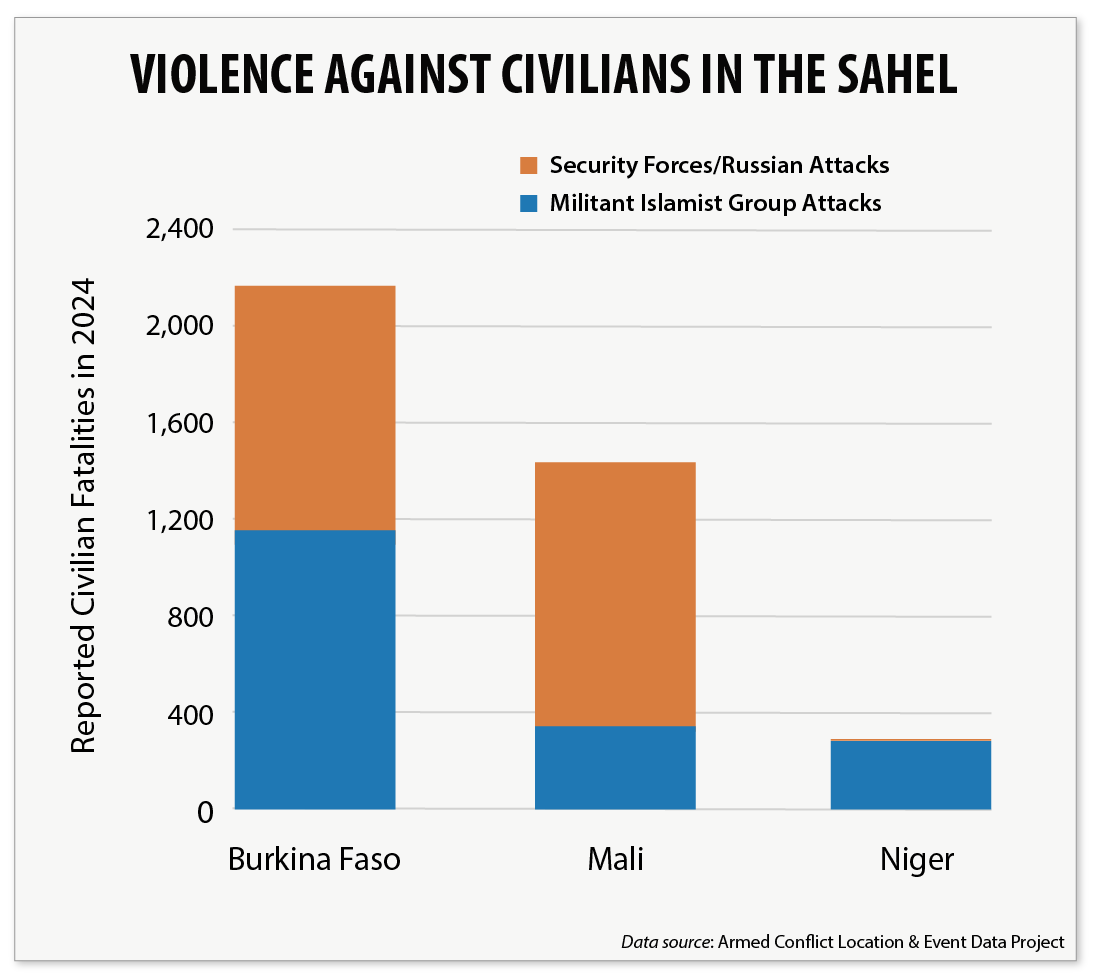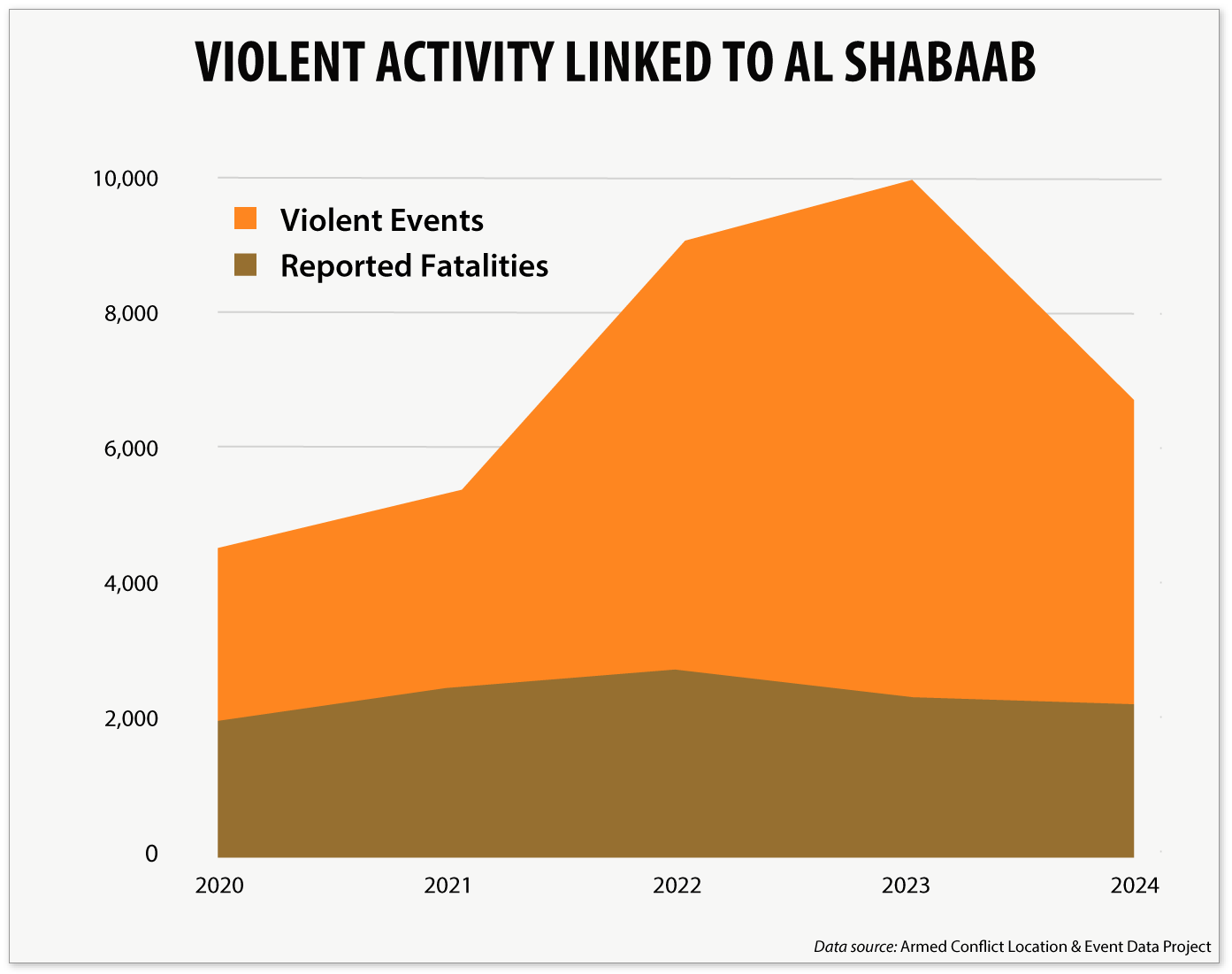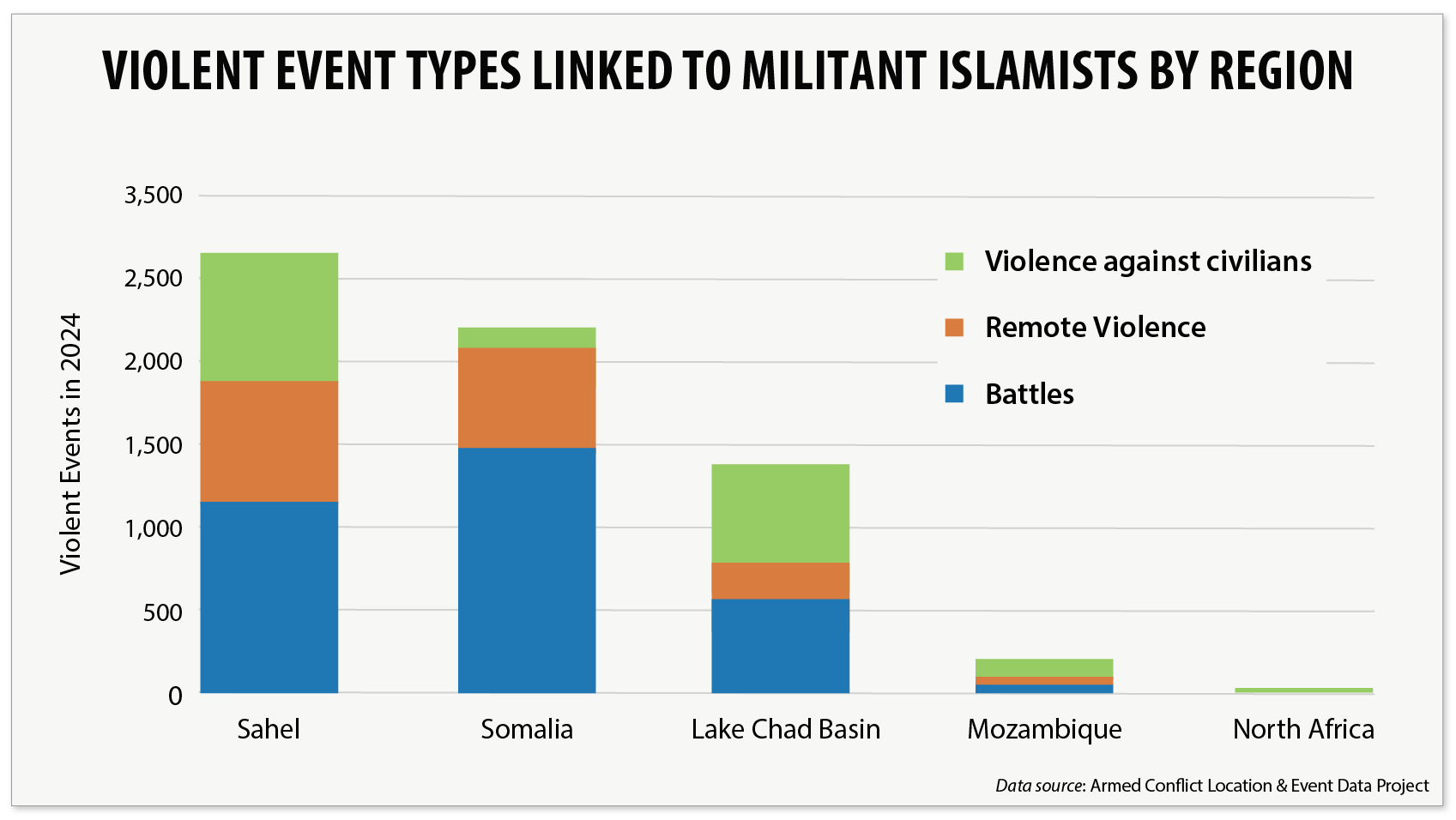Click here for printable PDF version.
Highlights
- There were an estimated 18,900 fatalities linked to militant Islamist violence in Africa in 2024.
- A sharp decline in deaths involving al Shabaab in Somalia brought the continental total below the record high levels of 2023 (23,000 fatalities). Nonetheless, the average annual total number of fatalities for the past 3 years was still more than a third higher than the period from 2019-2021.
The Sahel remained the most lethal theater on the continent for the fourth year in a row.
- The Sahel remained the most lethal theater on the continent for the fourth year in a row. There were an estimated 10,400 deaths linked to militant Islamist violence in the Sahel in 2024. This comprises 55 percent of all related fatalities for the continent.
- The Sahel also accounts for the most prevalence of violence against civilians—a metric of direct targeting of civilians by militant Islamist groups. The region accounts for 67 percent (1,840) of these civilian fatalities for the continent. The Lake Chad Basin region was second, comprising 24 percent (670) of such fatalities.
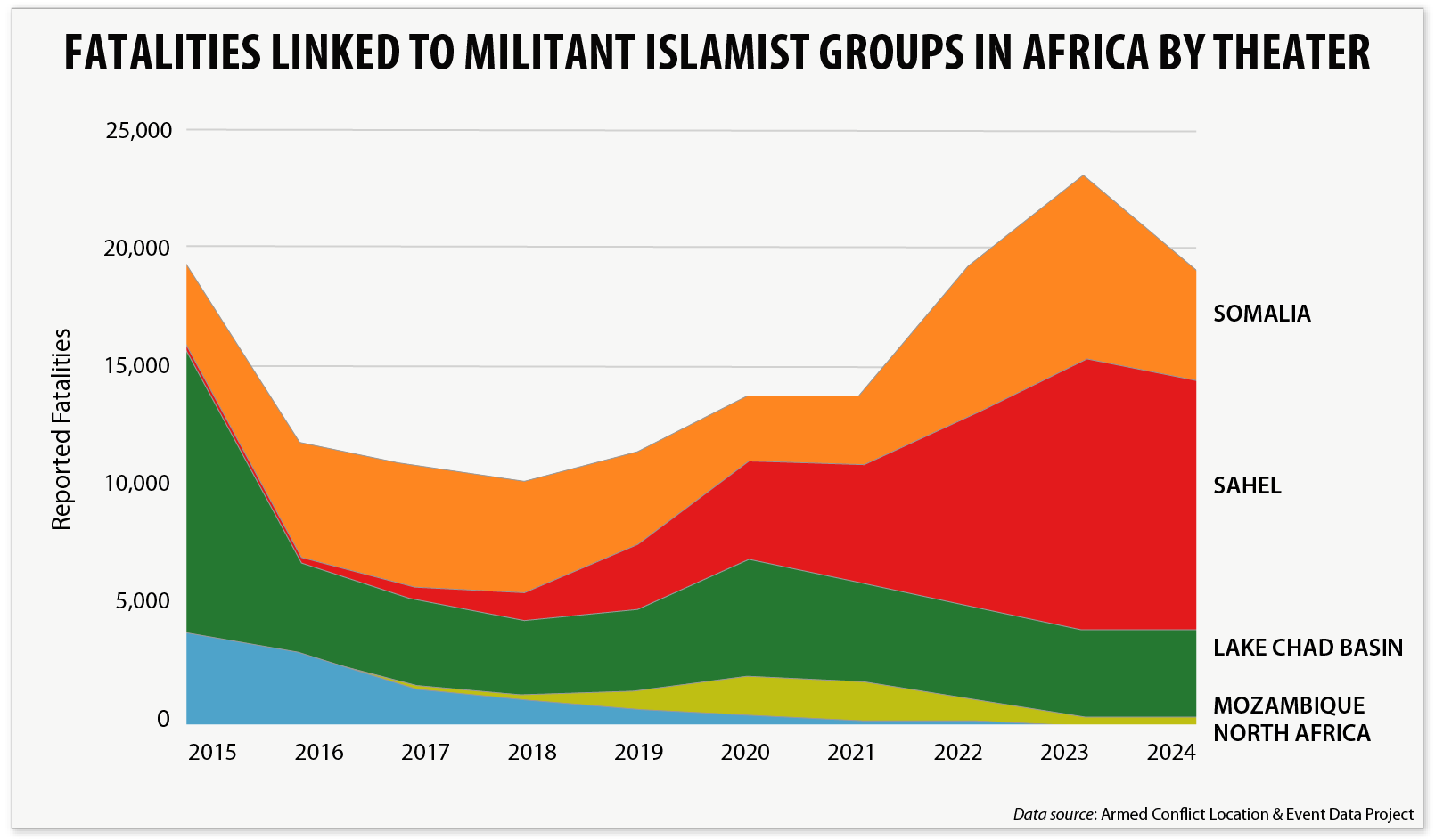
- Three theaters accounted for 98 percent of the reported fatalities linked to militant Islamist violence on the continent: the Sahel (55 percent), Somalia (24 percent), and the Lake Chad Basin (19 percent).
- Both Mozambique and North Africa saw increases in violent activity and reported fatalities following steady declines in previous years. Nonetheless, the two theaters account for just 2 percent of related fatalities.
Sahel
- Fatalities linked to militant Islamist violence in the Sahel remain more than two and a half times the levels seen in 2020, when the first military coup in the region occurred. Militant Islamist insurgencies have thus retained a high operational capacity despite the military juntas seizing power.
Militant Islamist insurgencies have thus retained a high operational capacity despite the military juntas seizing power.
- Recent years’ figures regarding militant Islamist violence in the Sahel must be viewed with caution. Given the increasingly repressive measures the military juntas have imposed on journalists, independent reporting of militant Islamist violence has been severely constrained—and therefore likely undercounted.
More civilians died due to the Sahelian and Russian security forces’ violence against civilians than by militant Islamist groups in 2024.
- The Sahel is noteworthy for the high percentage of episodes of violence against civilians linked to the military juntas and allied Russian forces. There were 356 such reported incidents in 2024, resulting in 2,109 fatalities—a 36-percent increase from the previous year.
- With 1,778 reported fatalities from violence against civilians linked to militant Islamist groups, more civilians died due to the Sahelian and Russian security forces’ violence against civilians than by militant Islamist groups in 2024.
- In Mali, 76 percent of reported violence against civilian fatalities were linked to the armed forces and allied militias, the highest of any of the three Sahelian countries facing militant Islamist insurgencies.
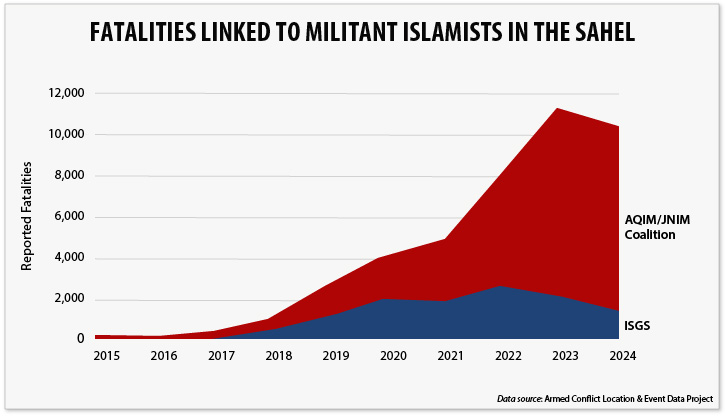
- 85 percent of violent events and fatalities linked to militant Islamist groups in the Sahel in 2024, were attributed to the Jama’at Nusrat al Islam wal Muslimin (JNIM) coalition, particularly the Macina Liberation Front and Ansaroul Islam.
- The Islamic State in the Greater Sahara (ISGS, also known as Islamic State-Sahel Province), is associated with just 15 percent of violent events and fatalities in the Sahel. This reflects a steady decline in violent activity by ISGS since 2022, when it accounted for a third of all fatalities in the region. In 2020, it was linked to half of all militant Islamist-related deaths. ISGS remains most active in Niger, where it is responsible for 86 percent of all violence against civilian fatalities.
- Burkina Faso has been the locus of militant Islamist violence in the Sahel since 2019. The country accounted for 61 percent of militant Islamist-related fatalities in the Sahel (6,389) in 2024. This compares to 23 percent of reported fatalities in Mali (2,443 deaths), underscoring the rapid expansion of the insurgency in Burkina Faso once it spilled over from Mali.
Burkina Faso has been the locus of militant Islamist violence in the Sahel since 2019.
- There has been a rise in mass atrocities committed by extremists in Burkina Faso. In August 2024, fighters linked to the JNIM coalition gunned down some 400 civilians outside the town of Barsalogho (Sanmatenga Province) in what is likely the largest massacre of civilians in Burkina Faso history.
- Militant Islamist violence in Mali remains concentrated in the central regions of Segou and Mopti which together account for nearly 60 percent (605 of 1,022) of the violent events recorded in the country. This is an increase of 11 percent compared to 2023 (557 events) and 50 percent compared to 2021 (408 events).
- Southern Mali, the country’s most densely populated zone, has also witnessed an alarming increase in militant Islamist group activity in recent years, with all three southern regions recording more than 30-percent increases in violent events.
Southern Mali has also witnessed an alarming increase in militant Islamist group activity in recent years.
- Illustrative of this growing brazenness, militants linked to the JNIM coalition mounted an attack on police and military bases as well as an airfield in September 2024. The attack resulted in the deaths of an estimated 77 Malian service members and the burning of the presidential plane.
- Since its coup in July 2023, Niger has seen a surge in militant Islamist violence. This translated into a 66-percent jump in militant Islamist-linked fatalities in 2024 (to 1,318 deaths) compared to 2023.
- Nigerien military forces have regularly faced ambushes from militant Islamist groups over the past year. These clashes have resulted in roughly a dozen cases where more than 10 Nigerien soldiers have been killed.
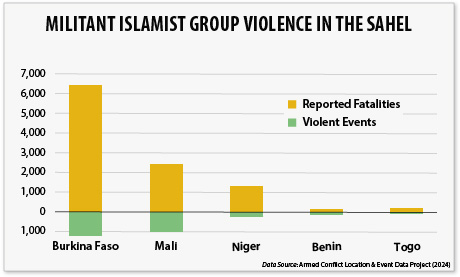
- The spread of militant Islamist violence in the Sahel continues to threaten the countries of coastal West Africa. Benin saw roughly an equivalent number of fatalities in 2024 (153) as 2023 (160). Meanwhile, Togo, experienced a 45-percent increase in fatalities (rising from 66 to 96 deaths).
- Best estimates are that there are now more than 4 million people displaced from Burkina Faso, Mali, and Niger. Roughly 3 million Burkinabe (10 percent of the population) have been forcibly displaced alone.
Somalia
- Somalia saw a 41-percent decrease in fatalities in 2024, bringing the number of fatalities (4,482) down to pre-2022 levels, when the Somali federal government launched a major offensive against al Shabaab. Nevertheless, the number of fatalities in 2024 was 72 percent higher than in 2020.
- The majority of violent events were linked to battles (66 percent), reflecting the continued focus of security forces against al Shabaab in combination with other, non-kinetic, attacks on the militant groups—such as on their financing.
The Islamic State in Somalia (ISS) has established a nerve center for its operations in the Puntland region of northeastern Somalia.
- The Islamic State in Somalia (ISS) has become an increasingly important financial conduit for the Islamic State’s worldwide network in recent years, having established a nerve center for its operations in the Puntland region of northeastern Somalia. This has been accompanied by an influx of foreign fighters from North Africa, the Gulf, and East Africa.
- ISS has largely kept a low profile in Somalia in recent years, save for some clashes with al Shabaab forces in the coastal towns of Bossaso and Qandala in Puntland. Airstrikes by the United States on the group’s hideouts in mid-2024 and at the beginning of 2025 have been aimed at disrupting this network.
- The decline in violent events and fatalities linked to al Shabaab in Somalia were mirrored in the Kenyan borderlands. Kenya saw an 11-percent drop in violent activity linked to al Shabaab (to 109 events) and a 32-percent drop in fatalities (to 188) from 2023.
- The conflict, combined with drought and flooding, has resulted in 4.4 million people (22 percent of the population) facing Crisis levels and above (IPC Phase 3+) of food insecurity in Somalia.
Lake Chad Basin
- Militant Islamist group-linked fatalities in the Lake Chad Basin declined by 4 percent from the previous year (to 3,627 deaths). This continues a 27-percent drop in fatalities observed in this region since 2020.
- Nevertheless, the Lake Chad Basin theater remains the third most violent and lethal on the continent, comprising 21 percent of all violent events and 19 percent of all fatalities linked to militant Islamist groups.
For the first time, there were more militant Islamist-linked violent events in Cameroon than Nigeria.
- Northeast Nigeria remains the focus of militant Islamist group activity in the Lake Chad Basin, accounting for 66 percent of all fatalities in the theater.
- There has been a sharp rise of violent events in northern Cameroon in recent years, including a 51-percent increase over the past year. As a result, for the first time, there were more militant Islamist-linked violent events in Cameroon (711) than Nigeria (592) in 2024.
- Boko Haram and Islamic State in West Africa (ISWA) were linked to roughly equal numbers of violent events and fatalities in 2024, continuing a pattern observed since 2022. Ansaru, located in northwestern Nigeria, was mostly absent.
- The two groups continue to fight over control of territory, resources, and fighters, resulting in high casualty counts.
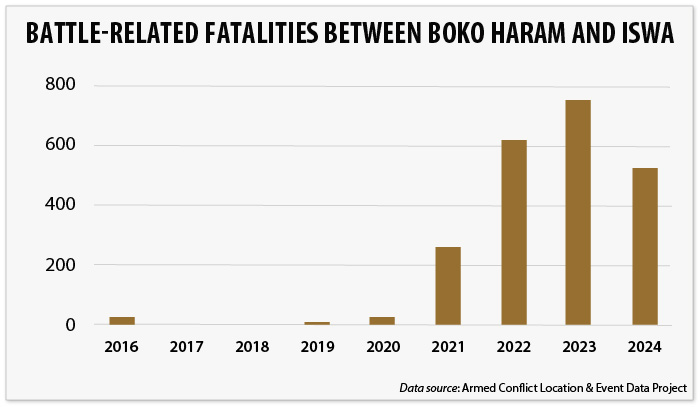
- The militant Islamist group violence, for the most part, is differentiated from the ever-growing groups of organized criminal groups (“bandits”) operating in northwestern Nigeria. This banditry is estimated to have been responsible for 1,380 violent events and 3,980 fatalities in 2024. This is roughly equivalent to the 1,392 violent events and 3,627 fatalities linked to militant Islamist groups during the same time frame.
Northern Mozambique
- Militant Islamist violence fatalities in northern Mozambique rose by 36 percent (to 349 deaths) in 2024, continuing its rolling trajectory of recent years.
The 31 percent of total fatalities resulting from violence against civilians in Mozambique is greater than any other militant Islamist group in Africa.
- Most of this rise was due to a sharp increase in violence against civilians. The 122 incidents targeting civilians made up 52 percent of the 236 total violent events in 2024.
- The Mozambique theater of militant Islamist violence has always been distinctive for its high rate of violence against civilians. The 31 percent of total fatalities resulting from violence against civilians in Mozambique is greater than any other militant Islamist group in Africa.
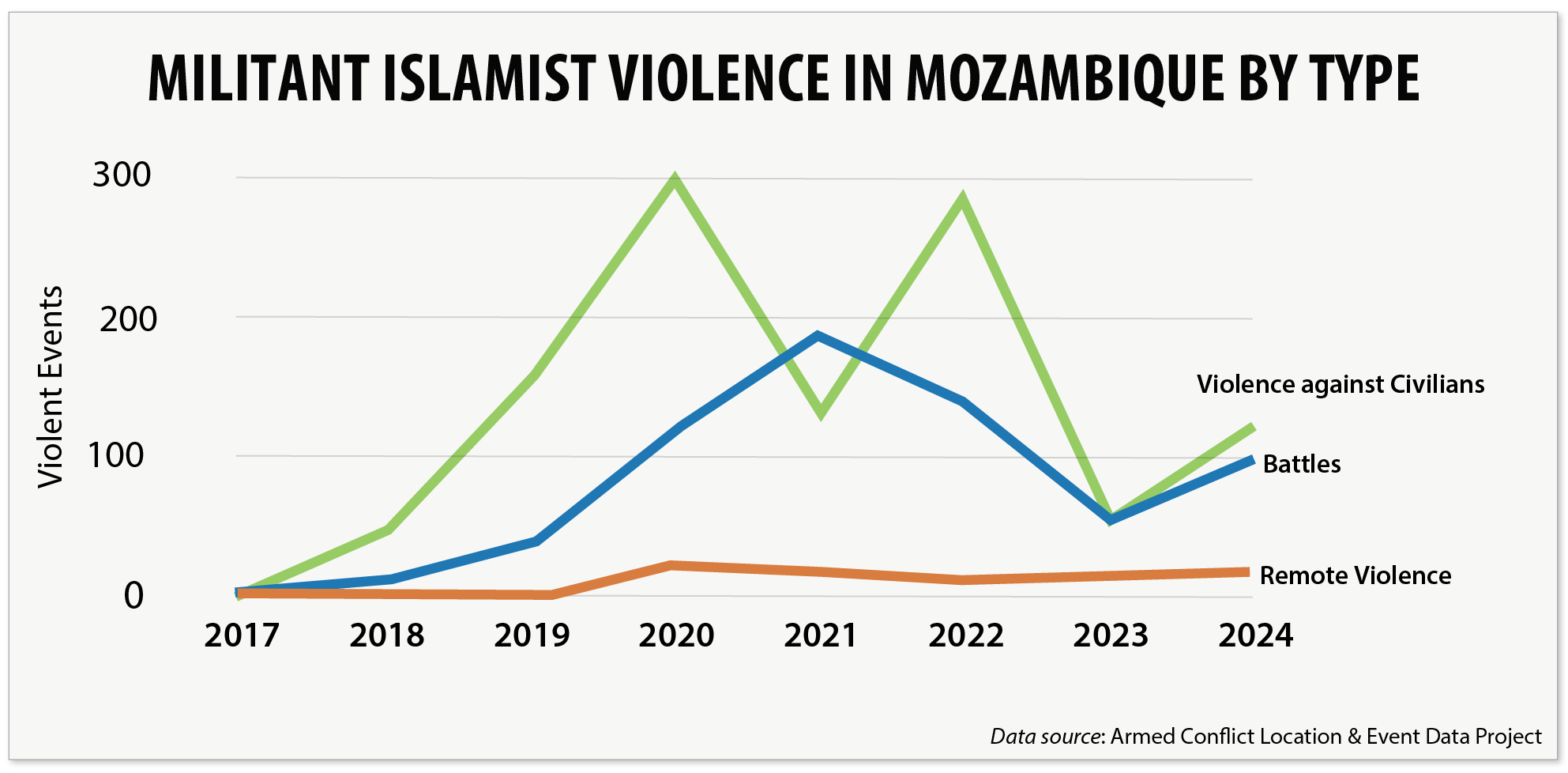
- The bounce back in levels of violence in Mozambique reflects ASWJ’s strategy to broaden the conflict by moving inland and into more rural areas. This is causing an overextension of Mozambican and Rwandan forces, who have been operating without SADC forces since mid-2024. Underlying grievances in the Cabo Delgado region remain to be addressed, fueling militant Islamist recruitment, particularly among youth.
- Roughly 578,000 people who have been displaced by the violence have yet to return to their homes.
North Africa
- Violent events linked to militant Islamist groups in the North African region remain low. There were only 10 reported events which caused 17 fatalities in 2024. In all but two of the events, security forces from Algeria and Libya targeted and killed militants.
Both the Islamic State in Libya and Al Qaeda in the Islamic Maghreb pose an ongoing threat.
- There were no reported violent events linked to militant Islamist groups in Egypt for the first time since 2010.
- The challenge for governments in the region will be to maintain the pressure on violent extremist actors. The United Nations and others believe that both the Islamic State in Libya and Al Qaeda in the Islamic Maghreb remain firmly embedded in the southern part of Libya and pose an ongoing threat.
